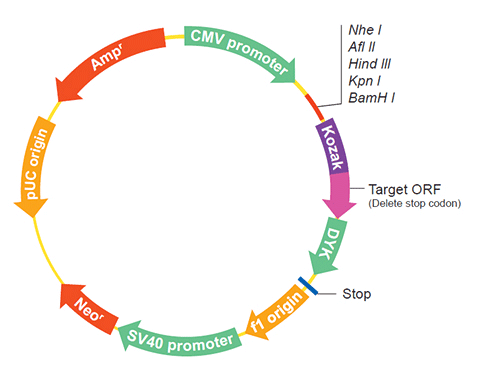| Gene Symbol | RSL24D1 |
| Entrez Gene ID | 697612 |
| Full Name | ribosomal L24 domain containing 1 |
| Gene Type | protein-coding |
| Organism | Macaca mulatta(Rhesus monkey) |
HOME
ORF » Species Summary » Macaca mulatta » RSL24D1 cDNA ORF clone
| Gene Symbol | RSL24D1 |
| Entrez Gene ID | 697612 |
| Full Name | ribosomal L24 domain containing 1 |
| Gene Type | protein-coding |
| Organism | Macaca mulatta(Rhesus monkey) |
| mRNA | Protein | Name |
|---|---|---|
| NM_001258062.1 | NP_001244991.1 | probable ribosome biogenesis protein RLP24 |

| RSL24D1 | XP_001089199.1 | |
| Canis lupus familiaris (dog) | RSL24D1 | XP_535488.2 |
| Gallus gallus (chicken) | LOC768911 | XP_001232073.2 |
| Drosophila melanogaster (fruit fly) | RpL24-like | NP_650073.1 |
| Eremothecium gossypii | AGOS_ADR346W | NP_984442.1 |
| Neurospora crassa | NCU05235 | XP_961999.2 |
| Homo sapiens (human) | RSL24D1 | NP_057388.1 |
| Rattus norvegicus (Norway rat) | Rsl24d1 | NP_001014234.1 |
| Danio rerio (zebrafish) | rsl24d1 | NP_998158.1 |
| Anopheles gambiae (African malaria mosquito) | AgaP_AGAP001545 | XP_321578.2 |
| Xenopus tropicalis (tropical clawed frog) | rsl24d1 | NP_001120140.1 |
| Pan troglodytes (chimpanzee) | RSL24D1 | XP_003952706.1 |
| Mus musculus (house mouse) | Rsl24d1 | NP_941011.1 |
| Kluyveromyces lactis | KLLA0E09439g | XP_454376.1 |
| Arabidopsis thaliana (thale cress) | AT2G44860 | NP_001078059.1 |
| Bos taurus (cattle) | RSL24D1 | NP_001073824.1 |
| Caenorhabditis elegans (roundworm) | rpl-24.2 | NP_492572.1 |
| Saccharomyces cerevisiae (baker's yeast) | RLP24 | NP_013109.1 |
| Magnaporthe oryzae (rice blast fungus) | MGG_10160 | XP_003713799.1 |
| Oryza sativa (rice) | Os07g0292800 | NP_001059399.1 |
| Oryza sativa (rice) | Os01g0514000 | NP_001043187.1 |

A new rhesus macaque assembly and annotation for next-generation sequencing analyses.
Zimin AV, Cornish AS, Maudhoo MD, Gibbs RM, Zhang X, Pandey S, Meehan DT, Wipfler K, Bosinger SE, Johnson ZP, Tharp GK, Mar?ais G, Roberts M, Ferguson B, Fox HS, Treangen T, Salzberg SL, Yorke JA, Norgren RB Jr
Biology direct9(1)20(2014 Oct)
GeneRIFs: Gene References Into Functions What's a GeneRIF?
The following RSL24D1 gene cDNA ORF clone sequences were retrieved from the NCBI Reference Sequence Database (RefSeq). These sequences represent the protein coding region of the RSL24D1 cDNA ORF which is encoded by the open reading frame (ORF) sequence. ORF sequences can be delivered in our standard vector, pcDNA3.1+/C-(K)DYK or the vector of your choice as an expression/transfection-ready ORF clone. Not the clone you want? Click here to find your clone.
| CloneID | OMb01294 | |
| Clone ID Related Accession (Same CDS sequence) | NM_001258062.1 | |
| Accession Version | NM_001258062.1 Latest version! | Documents for ORF clone product in default vector |
| Sequence Information | ORF Nucleotide Sequence (Length: 492bp) Protein sequence SNP |
|
| Vector | pcDNA3.1-C-(k)DYK or customized vector |  User Manual User Manual |
| Clone information | Clone Map |  MSDS MSDS |
| Tag on pcDNA3.1+/C-(K)DYK | C terminal DYKDDDDK tags | |
| ORF Insert Method | CloneEZ™ Seamless cloning technology | |
| Insert Structure | linear | |
| Update Date | 2019-04-27 | |
| Organism | Macaca mulatta(Rhesus monkey) | |
| Product | probable ribosome biogenesis protein RLP24 | |
| Comment | Comment: PROVISIONAL REFSEQ: This record has not yet been subject to final NCBI review. The reference sequence was derived from JU475848.1. On Apr 19, 2012 this sequence version replaced XM_001089199.2. ##Evidence-Data-START## Transcript exon combination :: CN643558.1, DR772503.1 [ECO:0000332] RNAseq introns :: mixed/partial sample support SAMEA4688315, SAMEA4688316 [ECO:0000350] ##Evidence-Data-END## | |
1 | ATGCGTATCG AGAAGTGTTA TTTCTGTTCG GGGCCCATCT ACCCTGGACA CGGCATGATG |
The stop codons will be deleted if pcDNA3.1+/C-(K)DYK vector is selected.
| RefSeq | NP_001244991.1 |
| CDS | 113..604 |
| Translation |

Target ORF information:
Target ORF information:
|
 NM_001258062.1 NM_001258062.1 |

1 | ATGCGTATCG AGAAGTGTTA TTTCTGTTCG GGGCCCATCT ACCCTGGACA CGGCATGATG |
The stop codons will be deleted if pcDNA3.1+/C-(K)DYK vector is selected.
A new rhesus macaque assembly and annotation for next-generation sequencing analyses. |